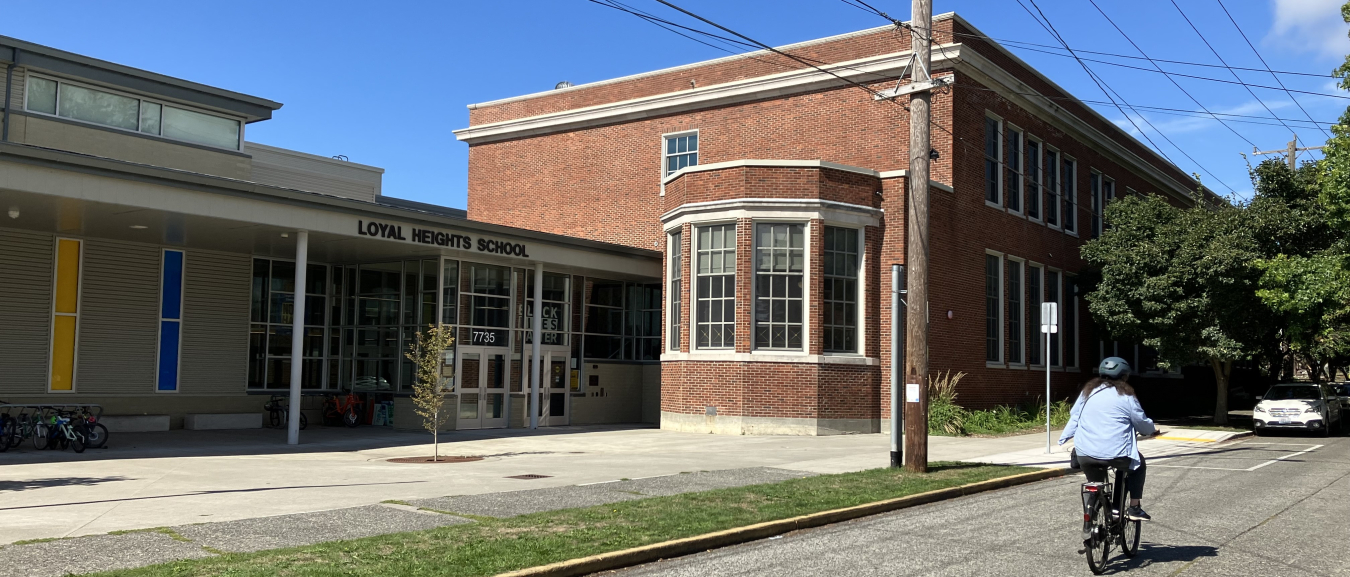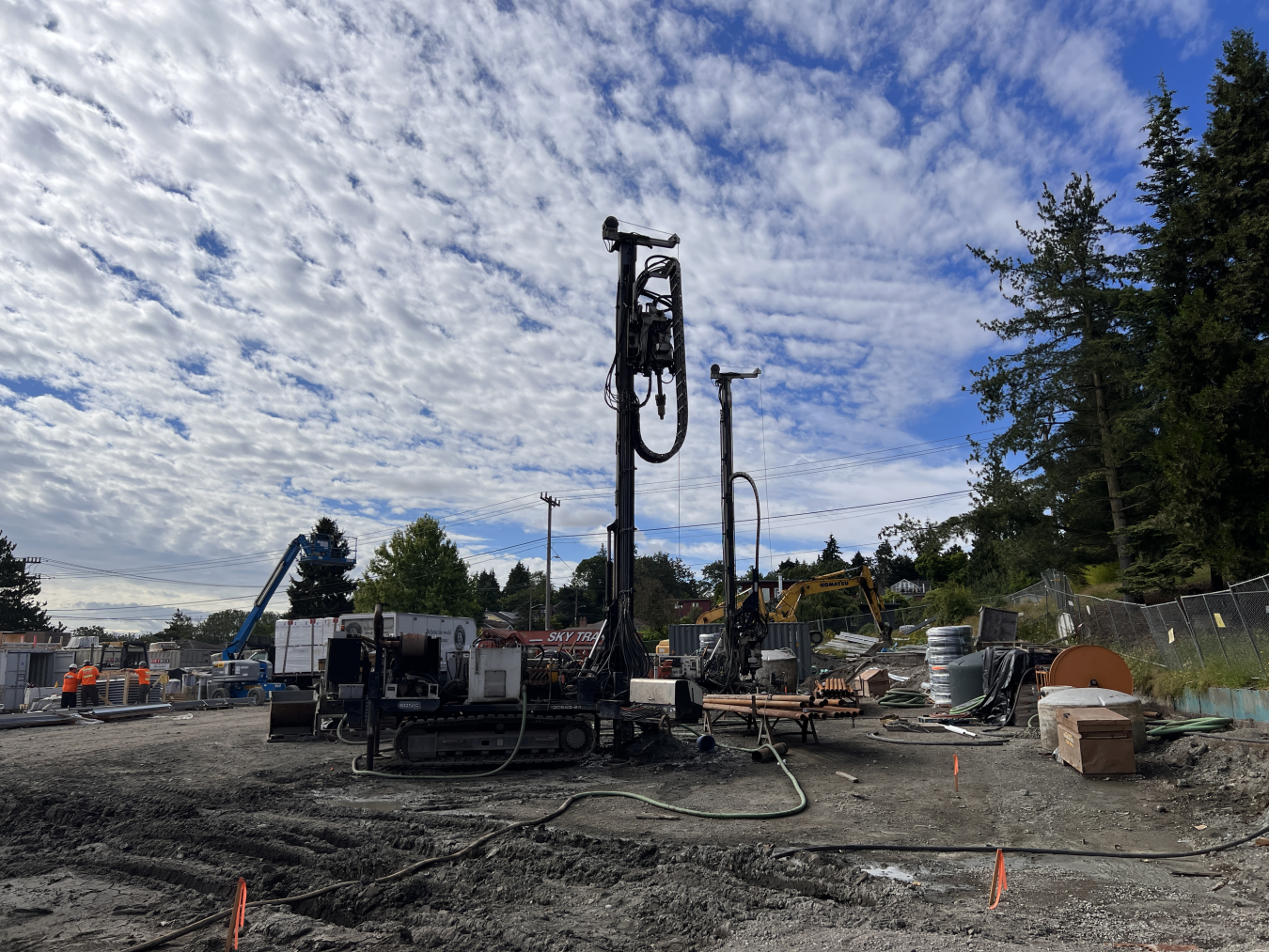
Loyal Heights School, part of Seattle Public Schools, uses a geothermal heat pump system with vertical closed loop boreholes. All systems are sized for 100% of the heating, cooling, and ventilation loads. Photo from Seattle Public Schools
Fast Facts
Location: Seattle, Washington
System Size:
- 15 existing schools; 4 being built
- A total of 1,131,770 square feet with another 650,000 square feet under construction
- Average elementary school system requires 90-100 boreholes drilled 150-350 ft deep
Download the full case study for additional fast facts.
Seattle Public Schools Lead on Advanced Heating and Cooling
When the Seattle Public Schools (SPS) facilities team floated the idea of switching from gas-fired boilers to geothermal heat pumps (GHPs) in 2004, they had no idea whether it would work. The only local use case that supported adopting the technology was an elementary school where a geothermal heat pump used for water storage had reduced the size requirements of a replacement boiler.
Fast forward two decades. Now geothermal heat pumps are the gold standard of heating and cooling for all new and remodeled SPS school buildings, and the facilities staff are the unsung heroes of an energy-efficiency success story.
Driving Innovation
The primary driver for transitioning to geothermal heat pumps was the school district themselves, not regulation. When SPS retrofitted James Madison Middle School with the first geothermal heat pump system, energy codes were not on most school districts’ radars.
“It was really the school district wanting to [do this] versus anything we were required to do,” SPS Director of Facilities Operations Frank Griffin said. “SPS did it because we thought it was the right thing to do.”
As it turned out, the decision also benefited their bottom line.

Photo from Seattle Public Schools
Energy Use:
- Geothermal heat pumps reduced weather-normalized energy use indexes 30%–77%, including during the coronavirus pandemic when increased ventilation was required.
- All retrofitted schools have replaced gas-fired boilers with geothermal heat pumps and electric boilers.
Unique Features:
- 100% geothermal heat pump heating, ventilating, and air-conditioning systems with electric boiler backup
- Seattle Public Schools has installed a combination of distributed heat pumps and centralized systems
- Several landmarked buildings have benefited from geothermal heat pump retrofits
Ahead of Code
All 15 remodeled or replaced schools in the district that have installed geothermal heat pumps have eliminated gas-fired boiler systems, along with their associated maintenance costs. At elementary schools, geothermal heat pumps have lowered the energy use intensity (EUI) from 42 to 15–20.
When comparing energy use across all buildings while accounting for weather variations, SPS has realized EUI reductions of 30%–77%, including when stepped-up ventilation increased electrical loads during the coronavirus pandemic.
“It was so successful right out of the gate, there really was no reason to look back,” said Mike Kennedy, the district’s mechanical, electrical, and plumbing coordinator for capital construction.
Energy codes have now been updated in Seattle, but SPS was far ahead of the curve on all counts.
Cost Rewards
“SPS now designs all facilities with geothermal heat pumps as our first go-to system as we continue to modernize or replace our school buildings,” said Ian Brown, one of the district’s three resource conservation specialists tasked with managing utility costs through low-cost and no-cost operating strategies.
The shift to geothermal heat pumps was foundational to the ongoing success of their efforts to improve building performance and comfort while lowering resource use and maintenance costs.
Benefits Increase With Technology Advances
SPS now aims to retrofit two to three schools per year, installing state-of-the art geothermal heat pump systems. Past systems have been funded by voter-approved property tax levies, but the district is exploring other funding sources for future projects.
Those schools will also benefit from two decades of advances in geothermal heat pump technology.
“The coefficient of performance is greater on those [new] units, so we don’t need to extract as much heat out of the ground,” Griffin said. “So the utility costs will actually go down more, and we’ll have more energy put into the classroom.”
“Our first project was James Madison Middle School in 2006. Our desire was an efficient HVAC system that reduced energy consumption, was easy to maintain, and had great longevity. SPS now designs all our facilities with geothermal heat pumps as our first go-to system as we continue to modernize or replace our schools.”
Ian A. Brown, Resource Conservation Specialist, Seattle Public Schools
Contacts:
For questions about this case study, contact Ian A. Brown, IABrown@SeattleSchools.org.
For any website technical issues or general questions about geothermal heat pumps, contact DOE.Geothermal@ee.doe.gov.
Printable Version
Download the printable Seattle Public Schools case study or visit the Geothermal Heat Pump Case Studies page to see more examples of geothermal heat pumps in action.

